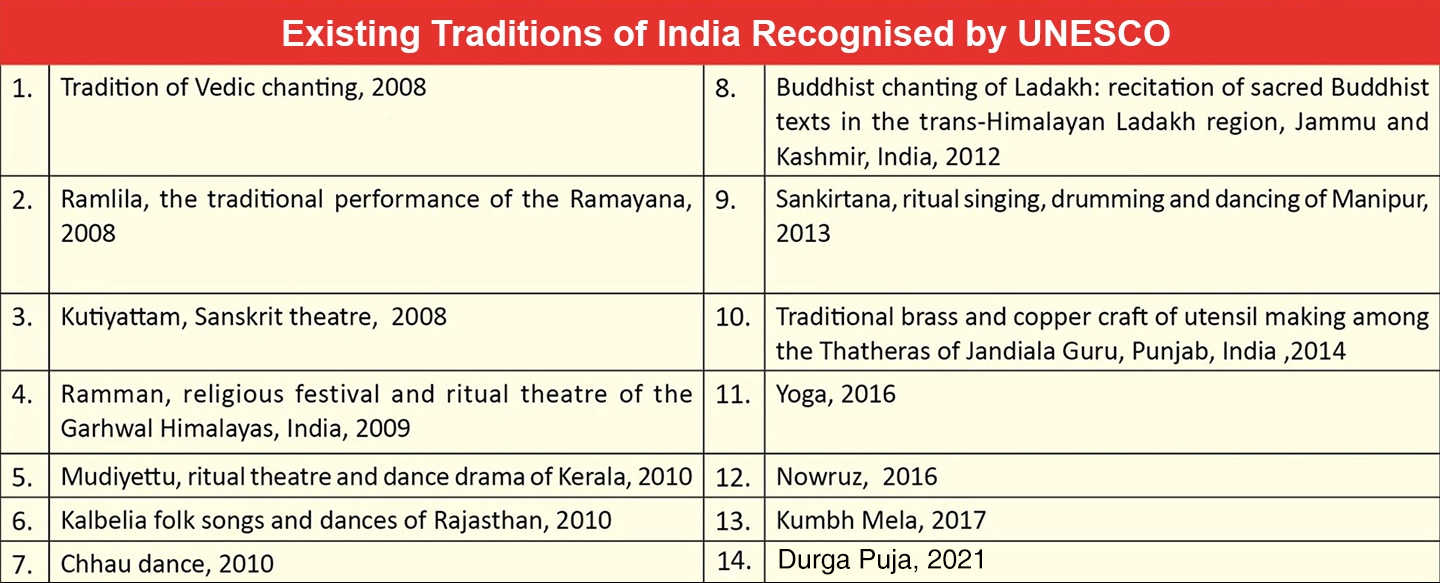Indian Economy
UNESCO Lists 50 Iconic Textile Crafts
- 01 Oct 2022
- 6 min read
For Prelims: UNESCO, Handloom, Sericulture
For Mains: Growth & Development, Inclusive Growth
Why in News?
Recently, UNESCO released a list of 50 exclusive and iconic heritage textile crafts of the country.
- One of the major challenges to the safeguarding of Intangible Cultural Heritage in South Asia is lack of proper inventory and documentation.
What are Some of the Important Textiles Crafts Listed?
- Toda embroidery and Sungudi from Tamil Nadu
- Himroo weaves from Hyderabad
- Bandha tie and dye weaving from Sambalpur in Odisha
- Kunbi weaves from Goa
- Mashru weaves and Patola from Gujarat
- Himroo from Maharashtra
- Garad-Korial from West Bengal
- Ilkal and Lambadi or Banjara embroidery from Karnataka
- Sikalnayakanpet Kalamkari from Tamil Nadu
- Khes from Haryana
- Chamba rumals from Himachal Pradesh
- Thigma or wool tie and dye from Ladakh
- Awadh Jamdani from Varanasi
What is UNESCO?
- About:
- It was founded in 1945 to develop the “intellectual and moral solidarity of mankind” as a means of building lasting peace. It is located in Paris, France.
- Major Initiatives of UNESCO:
What is Intangible Cultural Heritage?
- Intangible cultural heritage is the practices, expressions, knowledge and skills that communities, groups and sometimes individuals recognise as part of their cultural heritage.
- Also called living cultural heritage, it is usually expressed in one of the following forms:
- Oral Traditions
- Performing Arts
- Social Practices
- Rituals and Festive events
- Knowledge and Practices concerning nature and the universe
- Traditional Craftsmanship
- India has 14 intangible cultural heritage elements on the prestigious UNESCO Representative List of Intangible Cultural Heritage of Humanity.
What is the Status of the Textile Sector of India?
- About:
- Textiles & garments industry is labour intensive sector that employs 45 millions people in India is second only to the agriculture sector in terms of employment.
- India’s textiles sector is one of the oldest industries in the Indian economy, and is a storehouse and carrier of traditional skills, heritage and culture.
- It can be divided into two segments:
- The unorganised sector is small scale and uses traditional tools and methods. It consists of handloom, handicrafts and sericulture (Production of silk).
- The organised sector uses modern machinery and techniques and consists of the spinning, apparel and garments segment.
- Significance of the Textiles Sector:
- It contributes 2.3% to Indian Gross Domestic Product, 7% of Industrial Output, 12% to the export earnings of India and employs more than 21% of total employment.
- India is the 6th largest producer of Technical Textiles with 6% Global Share, largest producer of cotton & jute in the world.
- Technical textiles are functional fabrics that have applications across various industries including automobiles, civil engineering and construction, agriculture, healthcare, industrial safety, personal protection etc.
- India is also the second largest producer of silk in the world and 95% of the world’s hand-woven fabric comes from India.
What are the Initiatives related to the Textile Sector?
- Amended Technology Upgradation Fund Scheme (ATUFS): In 2015, the government approved the scheme for technology upgradation of the textiles industry.
- Scheme for Integrated Textile Parks (SITP): To assist small and medium entrepreneurs in the textile industry to clusterize investments in textile parks by providing financial support for world class infrastructure in the parks.
- Power-Tex India: It comprises new research and development in power loom textiles, new markets, branding, subsidies and welfare schemes for the workers.
- Silk Samagra Scheme: It focuses on improving the quality and productivity of domestic silk thereby reducing the country’s dependence on imported silk.
- Jute ICARE: This pilot project launched in 2015 is aimed at addressing the difficulties faced by the jute cultivators by providing them certified seeds at subsidized rates, and by popularizing several newly developed retting technologies under water limiting conditions.
- National Technical Textile Mission: It aims to position the country as a global leader in technical textiles and increase the use of technical textiles in the domestic market. It aims to take the domestic market size to USD 40 billion to USD 50 billion by 2024.
Way Forward
- For centuries, Indian textile crafts have dazzled the world with their beauty.
- Despite the pressures of industrial mass production and competition from new countries, it is essential that these iconic heritage crafts are taken stock of and promoted as contemporary treasures.
- The Textile sector has great potential, and it should be realised by using innovations, latest technology and facilitations.





